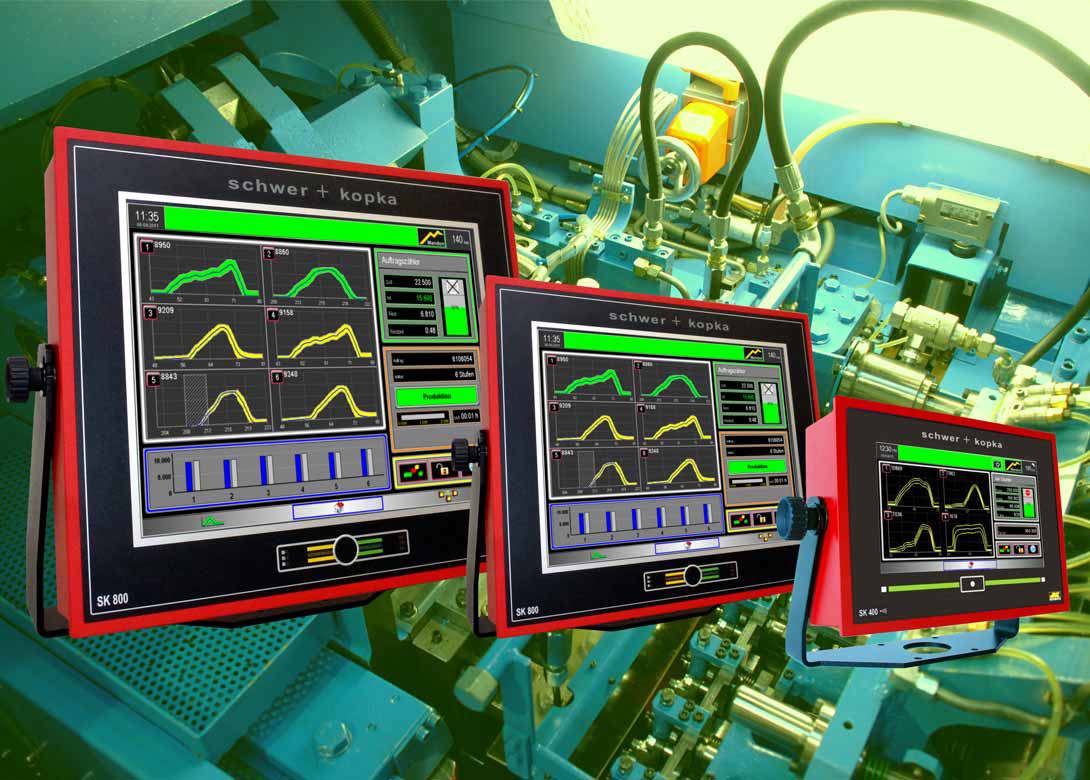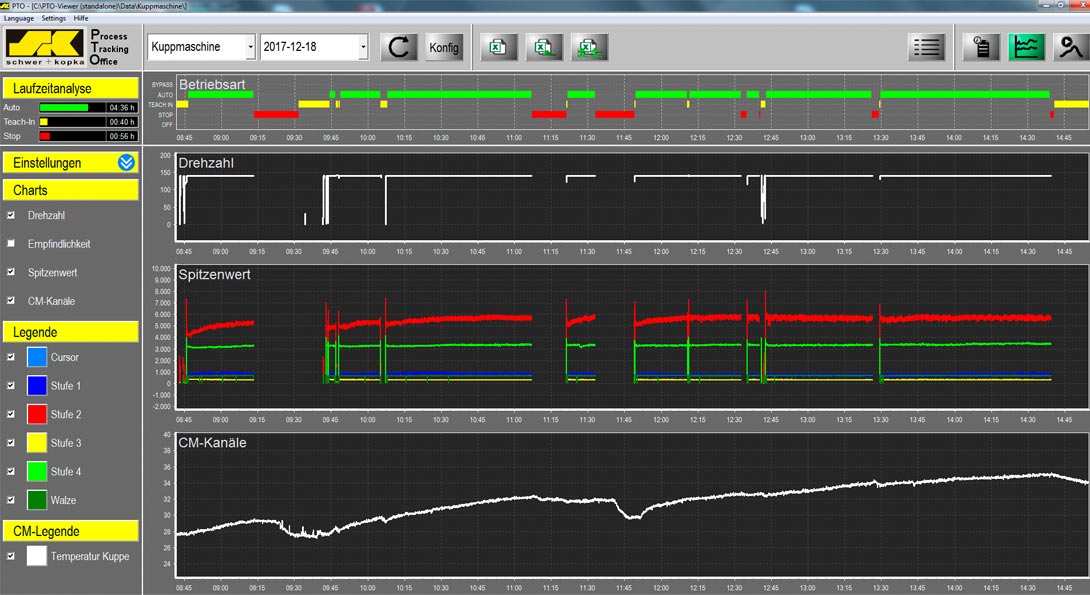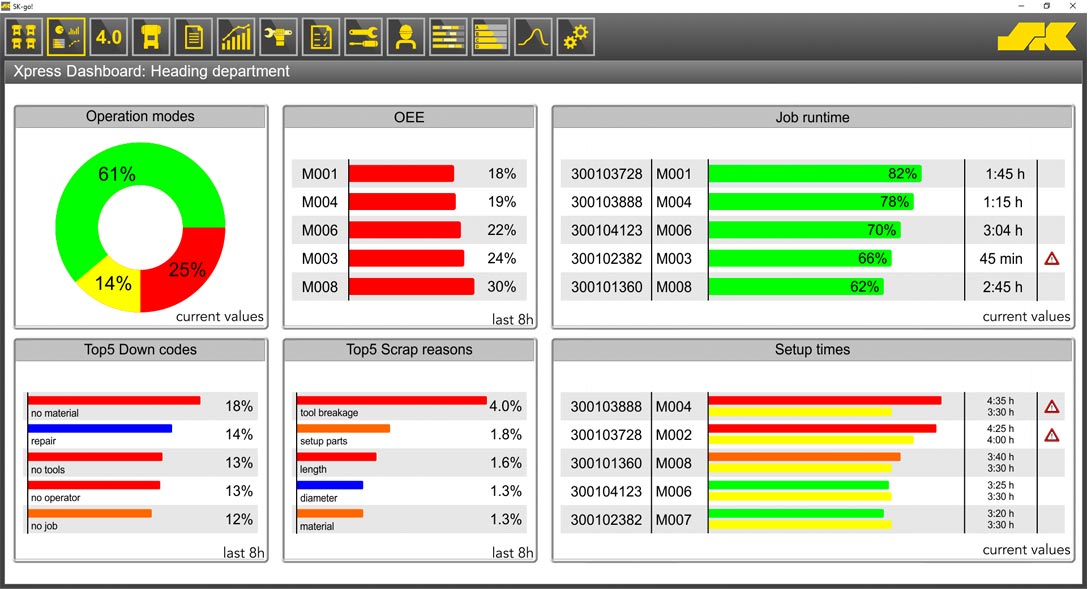
Founded in 1990, Schwer + Kopka GmbH has established itself as a leading provider of process monitoring systems, with its red boxes becoming synonymous with fastener manufacturing sites around the world.
Process and tool monitoring systems have been part of the cold forming industry for many years and ensure efficient and high-quality series production of a range of products, including stamped and bent parts, fasteners, formed parts, forgings, turned parts, as well as for assembly or joining operations.
“Process and tool monitoring systems act as the centralinformation control centre between the production floor and the higher level organisational systems – such as MES, CAQ and ERP,” states Wolfgang Faulhaber, managing director at Schwer + Kopka. “They guarantee a consistent product quality of the formed components even at the highest production speeds and protect machines and tools against overload damage at the same time.”
By using Schwer + Kopka’s (S+K) systems, customers’ processes can be monitored on a variety of different machines, including single and multi-die presses, boltmakers, nut formers, and thread rollers, plus equipment for secondary operations. “Our systems can monitor every part of the production process and can provide a whole host of information that is valuable for the manufacturer,” mentions Wolfgang.
S+K is solely responsible for the complete development and production of the hardware and software for its monitoring systems, which means it is able to react flexibly and quickly to the requirements of its customers and propose the right system for every situation. “Being responsible for the complete package is very important, as you can make sure every part of the system meets the highest quality standards and guarantees a first class performance,” points out Ralf Renz, division manager MES solution SK-go. “For instance, superior heat management ensures the electronics in our system consume as little energy as possible, thus keeping operating temperatures low and extending the service life of the electronic components. This means the PC-based systems work fan-less and with the latest Microsoft Windows operating systems.”
Ralf continues: “Through our experience and knowledge all of the monitoring terminals of the SK series house the complete electronics for the evaluation of the sensor signals, the visualisation of the process monitoring, and the data acquisition, whilst providing reliable, trouble-free operation even in the typically harsh environmental conditions of a production plant.”
Wolfgang adds: “All of our suppliers, where possible, are based within 100km of our headquarters. Only the items we cannot create ourselves – the PC main board or display – are from further afield. This ensures that we are able to guarantee the highest quality components are used for our systems. In addition, we have our own test equipment so we can check that all the components are suitable before we send the system to the customer.”

Monitoring techniques
S+K is able to offer a variety of monitoring techniques depending on the type of production the customer wants to observe. “For processes in the area of series production, monitoring the forces needed to manufacture the parts is the most suitable solution,” mentions Ralf. “Easy to install piezo‑electric sensors measure the loads on the tools such as forming forces, cutting forces or feed forces. The real power consumption of electric drive motors is also used for monitoring.”
Ralf continues: “In a learn cycle, the monitoring systems automatically memorise the typical force pattern as nominal curves for the parts that are currently running. The curve of each subsequently manufactured part is compared to the learned nominal curve and monitored for limit violations using various methods. Impermissible deviations lead to the immediate shutdown of the machine in order to avoid further defective parts and to protect the machine and tools against overload. Alternatively, sorting gates are activated that automatically separate defective parts. Sophisticated algorithms ensure even minor errors are reliably detected, while at the same time unnecessary machine shutdowns are avoided.”
The monitoring techniques S+K is able to supply customers, depending on their needs, include:
- Envelope monitoring with Mandonic: The monitoring electronics automatically creates an envelope band with upper and lower limits around the learnt force curve pattern. The Mandonic automatic monitoring system dynamically adjusts the width of the band to the spread of the process. It narrows where the force curves have a high repeatability and are stable and widens where the signal is more scattered.
- Foxmatic: This is a unique monitoring method, which works completely independent of the set envelopes. Foxmatic uses pattern recognition algorithms to tackle those errors that are not always reliably detected or not recognised at all using traditional envelope techniques. These include sporadically occurring errors such as cracks in fastener production, which are normally not detected with the usual random checks. Foxmatic can therefore even detect errors where force signal remains fully within the envelope.
- Peak force monitoring: For some manufacturing processes, monitoring the maximum forces occurring is the most suitable solution – for example, if the force curves tend to larger scatters. In this case, the current peak force is controlled with a lower and an upper limit. If the force value exceeds the upper limit, or if it is smaller than the lower limit, the machine is stopped immediately. The limits can be easily adapted to the current situation.
- Trend monitoring: Manufacturing processes can also change gradually. This does not always lead to errors, but one should keep an eye on the development. S+K trend monitoring clearly shows at a glance how the process signals change over time. Easily adjustable upper and lower trend limits ensure the process cannot move away more than allowed from the start.
- Monitoring process stability: Technical production processes always have fluctuations. For impeccable products, however, these should move within narrow limits. S+K measures the repeatability of the process signals (force curves) and uses them to calculate the PQI factor (process quality index) as a measure of process quality. Good and stable running processes show a PQI that is close to 100%. Just set a minimum PQI to stop a swelling process in time.
- Joining monitoring: Joining and assembly processes are often characterised in that certain force and/or travel points must be reached for a fail-safe joining product. S+K’s Vision 100 software is specifically designed for monitoring joining operations such as press fitting, riveting, clinching, caulking and similar operations.
The user can simply position the measurement windows for the particular application in free combination and specify how the joining force curve should pass through the windows. If desired, the force curve or certain segments of the force curve can be controlled by a dynamic envelope.

Suitable sensors
Each process monitoring system is also dependent on the quality of the measuring signal and thus on a suitable sensor type and the selected measuring point. “We develop, produce and sell a wide range of analogue and binary sensors for the most diverse areas of industrial sensing for the measurement of forces, pressure, strain, acoustic emission, vibrations, power consumption of electric motors, travels, angles of rotation, temperatures, etc,” mentions Wolfgang. “If you want to improve something in your production, you have to measure it and this always begins with an idea… and a sensor.”
S+K can provide a wide range of typical and commonly used sensors, depending on the application, including Superflex probes, Axflex longitudinal dowel, Bridgeflex, Diskflex, sensor screws, force measuring rings/load cells, Powerflex, X-Flex, rotary encoder/position transducer, and special designs.
“For electrical processing of the sensor signals, we also produce a programme of highly dynamic signal amplifiers. All sensors, together with the appropriate amplifiers, are designed to connect easily to our process monitoring systems,” says Ralf. “Thanks to our 30 years of experience, we are able to advise customers on the selection of the right monitoring system and sensor, depending on the measuring and monitoring task.”
Developing in partnership
To ensure its systems and sensors are always meeting the needs of the industry, S+K works with the leading fastener machine manufacturers. “This kind of partnership is mutually beneficial, as the machine manufacturers can gather a large amount of information on their machines, and how they operate under different conditions, and we can learn about new features and possibilities,” points out Wolfgang. “There are so many different types of cold forming machines, and new ones are entering the market all the time. We therefore need to make sure we are able to supply solutions for every machine. The market is fast and if you are not one of the first you have missed the opportunity.”
S+K is also working with these companies on Industry 4.0, which is currently a huge topic within the market. “Industry 4.0 has been a positive, but also a negative for us as a business,” explains Wolfgang. “The fastener sector as a whole is very traditional, which means Industry 4.0 is a big step for a lot of companies. We have customers contacting us saying they are interested in Industry 4.0 and they want to buy our system, but they don’t know what they need or what they want to measure.”
Wolfgang continues: “We are experts in networking and monitoring, but we are not experts in production. It is the customer that is the expert, so they need to define what measurements they want to record, and why. We can then work with them in partnership to provide a customised solution that can give them exactly what they require.”
To enable customers to collect all relevant data from the connected machines and monitor the results, S+K has introduced its MES software SK-go®, with a new version – SK-go Express being launched at Fastener Fair Stuttgart. “SK-go is able to tap into the data from all types of machines and provide vital information such as up and down times, reasons for breakdowns, production volumes and speeds,” points out Ralf. “From the gained data the system can calculate a range of statistics that clearly present flaws in production, which can be addressed by production management. This data can also be stored and archived to generate reliable evidence of stable, repeatable and controlled processes.”
“Our state of the art monitoring systems are used on every continent and enable us to provide valuable information to manufacturing customers that are looking to monitor and improve their production processes,” concludes Wolfgang. “Processing monitoring will undoubtedly be at the forefront of where the fastener industry will be heading in the future. Through our systems, which can be used on old machines and the latest technology, customers will be able to analyse key processes to find the most optimal solutions – guaranteeing first class production. We have introduced a multitude of trend setting, technological developments over the last 30 years and we will continue to do so.”

Biog
Will joined Fastener + Fixing Magazine in 2007 and over the last 15 years has experienced every facet of the fastener sector - interviewing key figures within the industry and visiting leading companies and exhibitions around the globe.
Will manages the content strategy across all platforms and is the guardian for the high editorial standards that the Magazine is renowned.








